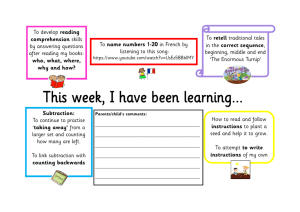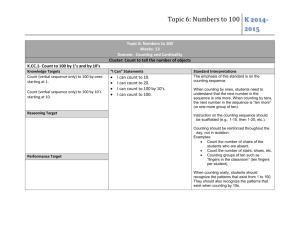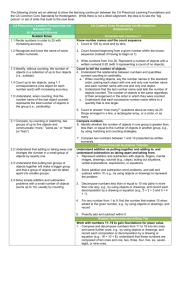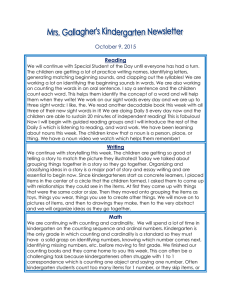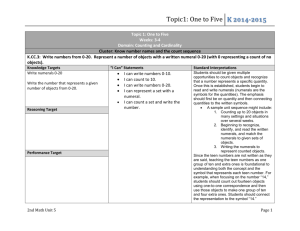Topic 5: Numbers to 20
advertisement
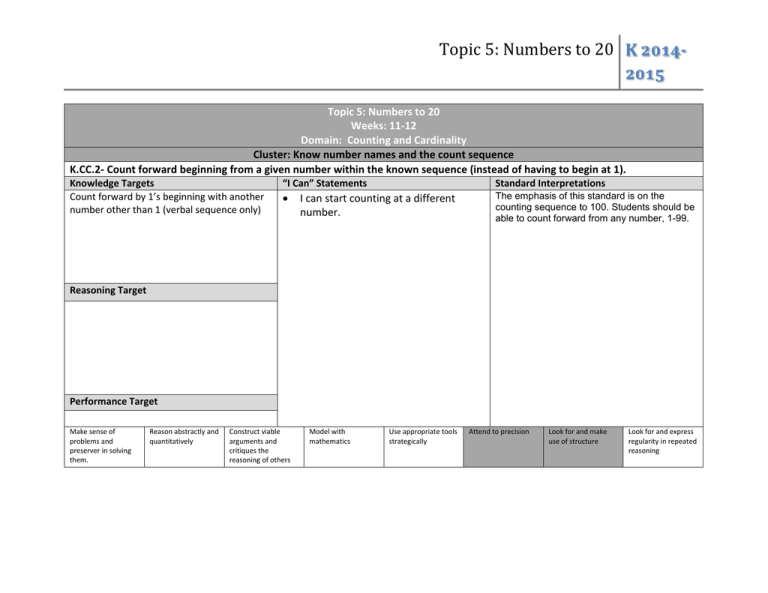
Topic 5: Numbers to 20 K 20142015 Topic 5: Numbers to 20 Weeks: 11-12 Domain: Counting and Cardinality Cluster: Know number names and the count sequence K.CC.2- Count forward beginning from a given number within the known sequence (instead of having to begin at 1). Knowledge Targets Count forward by 1’s beginning with another number other than 1 (verbal sequence only) “I Can” Statements Standard Interpretations The emphasis of this standard is on the counting sequence to 100. Students should be able to count forward from any number, 1-99. I can start counting at a different number. Reasoning Target Performance Target Make sense of problems and preserver in solving them. Reason abstractly and quantitatively Construct viable arguments and critiques the reasoning of others Model with mathematics Use appropriate tools strategically Attend to precision Look for and make use of structure Look for and express regularity in repeated reasoning Topic 5: Numbers to 20 K 20142015 Cluster: Count to tell the number of objects K.CC.4abc Understand the relationship between numbers and quantities; connect counting to cardinality. a. When counting objects, say the number names in the standard order, pairing each object with one and only one number name and each number name with one and only one object. b. Understand that the last number name said tells the number of objects counted. The number of objects is the same regardless of their arrangement or the order in which they were counted. c. Understand that each successive number name refers to a quantity that is one larger. Knowledge Targets Represent quantities using numbers and represent numbers using quantities Reasoning Target Match each object with one and only one number name and each number with one and only one object. Recognize the number of objects is the same regardless of their arrangement or the order in which they were counted. Realize that the last number name said tells the number of objects counted. Generalizes that each successive number name refers to a quantity that is one larger. Performance Target When counting objects, say the number names in order while matching each object with a number. “I Can” Statements Standard Interpretations This standard focuses on one-to-one correspondence and how cardinality connects with quantity. For example, when counting three bears, the student should use the counting sequence, “1-2-3,” to count the bears and recognize that “three” represents the group of bears, not just the third bear. A student may use an interactive whiteboard to count objects, cluster the objects, and state, “This is three”. I can say the numbers in order. I can say one number for each object. I can explain that the last number tells how many. I can explain how to count if I mix them up, the number is still the same. I can explain when counting that the next number always means one more. In order to understand that each successive number name refers to a quantity that is one larger, students should have experience counting objects, placing one more object in the group at a time. For example, using cubes, the student should count the existing group, and then place another cube in the set. Some students may need to re-count from one, but the goal is that they would count on from the existing number of cubes. S/he should continue placing one more cube at a time and identify the total number in Topic 5: Numbers to 20 K 20142015 order to see that the counting sequence results in a quantity that is one larger each time one more cube is placed in the group. Make sense of problems and preserver in solving them. Reason abstractly and quantitatively Construct viable arguments and critiques the reasoning of others Model with mathematics Use appropriate tools strategically Attend to precision Look for and make use of structure Look for and express regularity in repeated reasoning Topic 5: Numbers to 20 K 20142015 Vocabulary Eleven Twelve Thirteen Fourteen Fifteen Sixteen Seventeen Eighteen Nineteen Twenty



